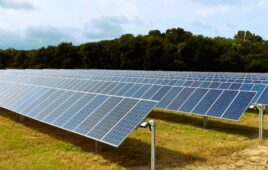By Doug Grubbs, applications engineer at Morningstar Corp.
Being able to remotely monitor PV systems is important to reducing time and costs associated with site visits. This is obviously especially important for off-grid systems, which are often in even harder to reach or remote areas—geological monitoring, mines, telecom, industrial automation and agriculture applications.
Other, more accessible off-grid systems can also benefit if they remain unattended for long periods of time. This includes lighting, security, traffic monitoring, leisure (marine, cabins, RVs), pumping systems and cellular towers. Moreover, some residential and municipal applications with on-site personnel can benefit, if an installer or someone who understands the system is not available. Lastly, many battery-based residential, battery backup, rural electrification (homes, schools and hospitals) and UPS systems that are temporarily unattended may warrant remote visibility into system metrics.

Telecommunications repeater station in Canada. -Photo courtesy of Howell Mayhew Engineering.
Demand for remote monitoring and control in off grid renewable systems is being driven by the need to:
- Reduce costs associated with remote site visits.
- Receive quick notification and act to eliminate power interruptions at a site.
- Facilitate troubleshooting
- Program custom settings off-site
- Update firmware remotely
Remotely monitoring off-grid systems is slightly more complicated than with grid-tied systems, because you must consider the historic charge/discharge state of the battery in addition to the energy production of the solar PV array.
Options for remote monitoring systems
The most basic remote monitoring systems provide the user with real-time information such as battery voltage, battery charging state (bulk, absorption, float, night etc.), charge current, load current, Ahs and/or kWh, load state (on/off), temperatures (battery, ambient, heat sink).
More advanced remote monitoring allows for viewing or downloading internally logged data of daily values (charge Ahs, Load Ahs, Max. Battery Voltage, Min Battery Voltage) and events (Minutes in Absorption, Float and Equalize, Faults and Alarms). The historic daily values provide much needed information about how the system has been performing.
For example, if the daily absorption charging minutes is very low and no float charging minutes are recorded, this indicates that the batteries did not get completely charged that day. If such a trend continues over several days, this could indicate the need for a larger PV array, loads to be shut off or remote backup generator startup.
Consider another example when a battery bank nears the end of its life. The battery might reach a full state of charge during the day, but the daily low battery voltage might begin to get unusually low. Of course, it is also entirely possible that the daily loads have increased. Checking the daily load Ah will indicate if the battery seems to be providing fewer Ahs that it had previously. For some customers who have critical power needs the daily Ahs and minimum daily battery voltage information will help evaluate the health of the battery and if it needs to be replaced.
More advanced monitoring solutions include real-time live data logging directly from the controller to a data log file. This can be recorded in much shorter intervals than once a day with a continuous connection to the controller(s). This detailed information throughout the day can provide more insight about energy usage and production. In addition, it is helpful to review detailed information for troubleshooting faults and alarms to see what was taking place at the time a fault occurred. For example, a load surge can cause a brief overcurrent condition that may be appearing in the daily log file. Many people want to see if this type of infrequent fault or alarm is a problem or not. Continuous data logging can shed more light on something that may be showing up in the daily log files.

Daily logged data of a remote off-grid system.
New trends
There is a strong trend for solutions that offer MODBUS RTU and MODBUS over IP, which is an open protocol standard being adopted by the SunSpec Alliance. Many third-party software solutions have been developed with remote serial communications or Ethernet adapters. For many of these solutions, data logging stops if the connection is lost.
However, new Ethernet adapters are being complemented with web monitoring services which do not require a continuous connection from a computer. By including internal memory, if the remote connection is ever lost, the adapter will automatically upload the missing data to the web server when it reconnects to the internet.
For customers who have many solar PV sites, these new internet PV system monitoring solutions provide a multi-controller system status screen. This allows customers to see any potential issues with many sites at once at a quick glance.
In some cases monitoring may reveal information that will inspire a customer to intervene and control the system in some way. Certain faults may require a reset, which can be implemented remotely. It is also possible to remotely control devices to shut off loads to help the battery recover from a low state of charge or disable charging, if necessary.
Establishing a remote connection to a device allows users to program custom settings off-site. This is especially useful for systems that may need seasonal or small adjustments to the custom settings for improved performance. Software programs like Morningstar’s MSView allows setting custom settings remotely.
Remote connections are also starting to be able to facilitate remote firmware updates to enable new product features, improve performance or fix problems discovered in the field. The need to better monitor, remotely program settings and update firmware were the impetus behind the development of converters like the Ethernet MeterBus Converter (EMC-1).
Taking time to focus on these considerations for remote monitoring for your system(s) will help you achieve more with less truck rolls, enabling you to conduct smarter business.




How can you disable a remoter connection and control the system yourself? My supplier has threatened to disable my system over an issue of the final payment. They have been appalling in regard to deadlines, communications etc and we are afraid that if we pay we will never receive guarantees!
What sort of data collection mechanism is the article talking about? Is it based on sensors? If so, what are the different sensors used to measure parameters like battery charging state and load state?
I have the same question…..I have a MagnaSine MS4448 and a Outback FlexMax 80. A bank of 16 Crown batteries. Would like to monitor the status from the house. This is all off-grid, so the solution needs to take that into consideration. Anyone have a suggestion??
I was trying to figure out what wire I would use to monitor from the house the inverters and batteries that are out in a shed by the garage without having to go out there to see what is up.